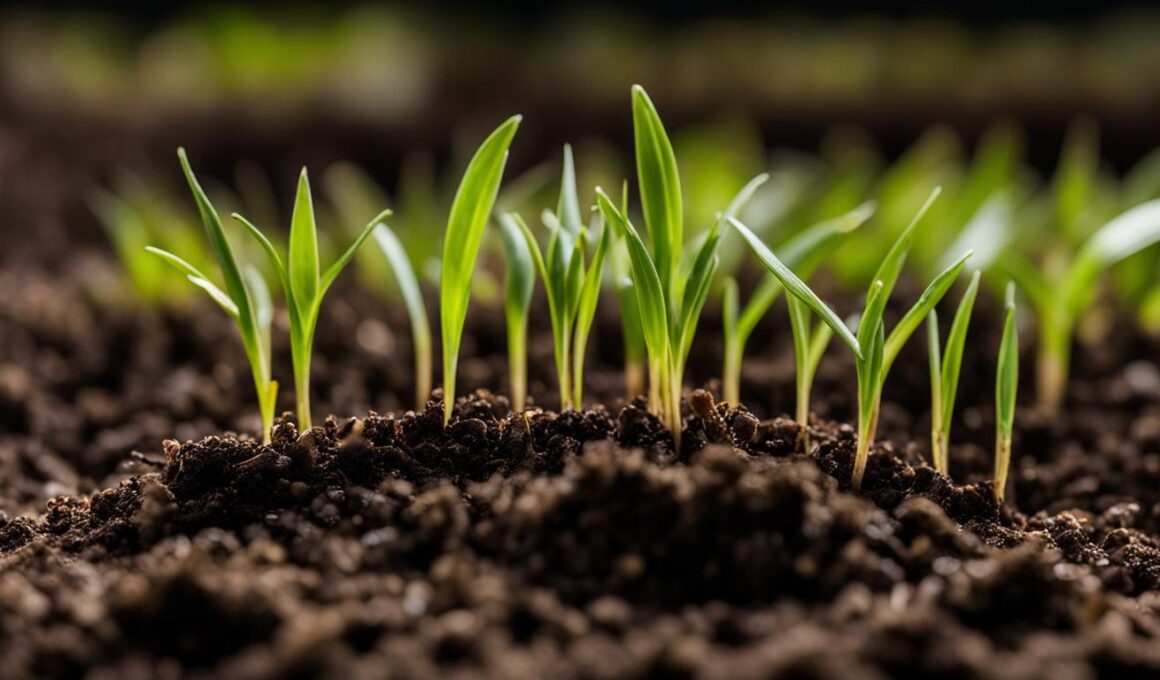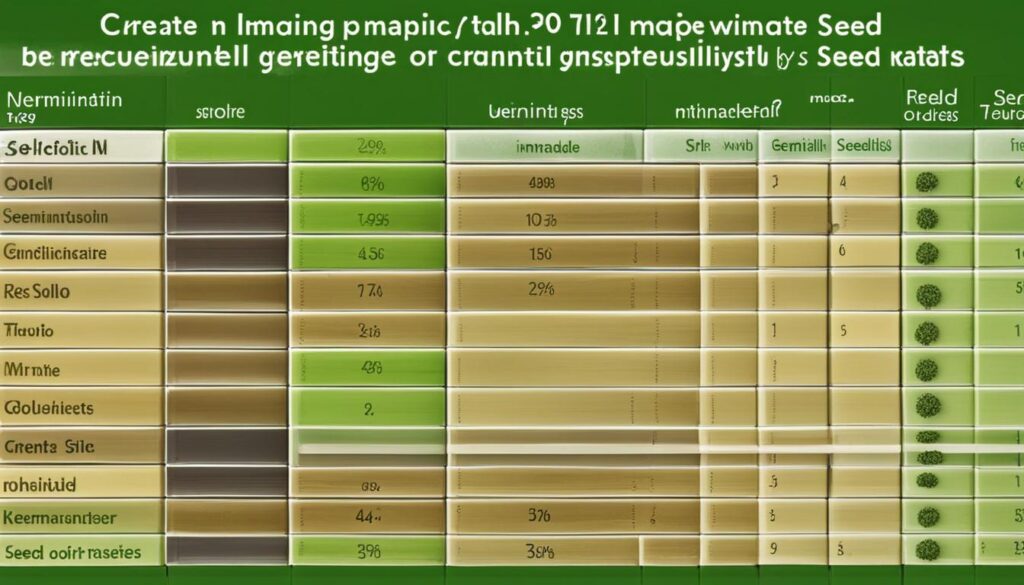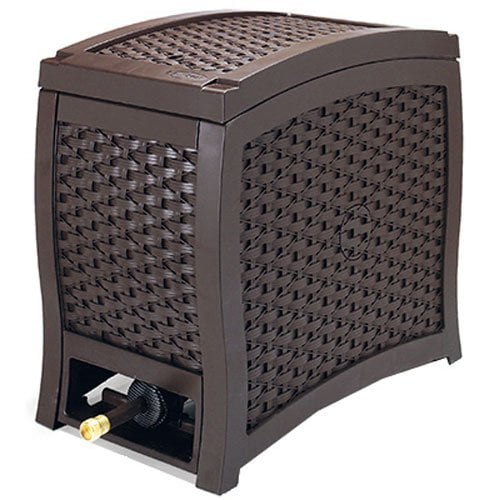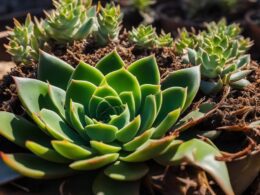If you’re considering planting grass seeds, you may be wondering if they will germinate on top of the soil. The good news is that grass seeds can indeed germinate when placed on top of the soil surface. In fact, this method is recommended by experts to help promote successful germination and growth.
When planting grass seeds on top of soil, it’s important to take certain measures to ensure optimal conditions for germination. By following these steps, you can increase the chances of success and achieve a beautiful, lush lawn.
Post Summary
- Grass seeds can germinate on top of the soil surface.
- Placing a thin layer of mulch or topsoil over the seeds can help keep them moist and warm, promoting growth.
- The ideal depth for planting grass seeds is only ¼ inch.
- Adequate soil moisture and temperature are crucial for successful germination.
- Proper soil preparation, pH testing, and maintenance techniques are essential for seed germination and lawn growth.
The Importance of Proper Depth
When it comes to planting grass seeds, the depth at which you sow them plays a crucial role in their germination. Proper depth ensures that the seeds receive the right amount of moisture, warmth, and oxygen to facilitate growth. It is recommended to plant grass seeds at a depth of only ¼ inch. Planting them deeper or covering them with too much soil can hinder germination. To provide optimal conditions for seed germination, gently press the seeds into loosened soil, ensuring good seed-to-soil contact. It is also advisable to use a very thin layer of seedling cover or mulch to protect the seeds from washouts and birds.
To emphasize the importance of proper depth, consider the following analogy: just like a delicate flower needs to be planted at the correct depth to grow and bloom, grass seeds require the right conditions to sprout and establish a strong root system. Planting them too deep can suffocate the seeds, preventing them from accessing essential resources for germination. By following the recommended planting depth, you give the seeds the best chance to germinate and thrive.
Proper depth is particularly crucial for grass seeds as they have relatively small and delicate embryos that need access to light and air to grow. Planting them too deep can deprive them of these vital elements. Additionally, shallow planting allows the seeds to benefit from the warmth of the sun, which aids in the germination process.
Ensuring Success with Proper Depth
To ensure success with your grass seed germination, keep in mind the following tips:
- Prepare the soil by removing debris, loosening it, and removing any weed competition.
- Spread the grass seeds evenly over the prepared soil.
- Gently press the seeds into the soil to promote good seed-to-soil contact.
- Use a very thin layer of seedling cover or mulch to protect the seeds.
- Water the seeded area lightly and regularly to keep the soil moist.
- Monitor the germination progress and make any necessary adjustments to ensure optimal growth.
By following these guidelines and paying attention to proper depth, you can maximize the chances of successful grass seed germination and establish a healthy, vibrant lawn.
Germination Time
When it comes to grass seed germination, the time it takes for the seeds to sprout can vary. Different grass seed varieties have different germination times, typically ranging from 5 to 30 days. For example, Jonathan Green’s Black Beauty Ultra grass seed mixture germinates in 7-14 days, while their Fast Grow Grass Seed can sprout in just 7 days. The specific grass seed blend you choose can also affect germination time.
| Grass Seed Variety | Germination Time |
|---|---|
| Black Beauty Ultra | 7-14 days |
| Fast Grow Grass Seed | 7 days |
| Other Varieties | 5-30 days |
It’s important to note that these germination times are approximate and can be influenced by external factors such as soil moisture, temperature, and overall growing conditions. However, by selecting a fast-germinating grass seed variety like Fast Grow, you can accelerate the timeline and see results in as little as one week.
When planting grass seeds, it’s crucial to have patience and provide the optimal conditions for germination. Maintain proper soil moisture, ensure the soil temperature is suitable for seed growth, and follow recommended seeding techniques to maximize the chances of successful germination.
Factors Affecting Germination
For successful grass seed germination, several factors come into play. Two critical factors are soil moisture and soil temperature. Adequate soil moisture is essential as it provides the necessary environment for the seeds to sprout and grow. If the soil is too dry, the seeds may struggle to germinate. Similarly, extreme moisture can also hinder germination. It is important to maintain an optimal level of moisture to support seed germination.
Soil temperature is another crucial factor. Seeds require a specific temperature range to germinate effectively. If the soil is too cool or too warm, the seeds may fail to sprout. Different grass varieties have different temperature preferences for germination, so it is vital to consider the specific requirements of the grass seed being planted.
“Adequate soil moisture and appropriate temperatures are essential for successful germination.”
Another factor that can impact germination is the age of the seed. Older seeds tend to have a lower germination rate compared to fresh seeds. Over time, the viability and vigor of seeds diminish, reducing their ability to sprout and grow. It is advisable to use fresh seeds or perform a viability test on older seeds to determine their germination potential before planting.
Germination Factors Summary:
- Soil moisture: Maintain optimal moisture for sprouting and growth.
- Soil temperature: Provide the appropriate temperature range for germination.
- Seed age: Consider using fresh seeds for higher germination rates.
By understanding and managing these factors, you can greatly increase the chances of successful germination and establish a healthy, vibrant lawn.
Testing Seed Viability
To determine if grass seed is still viable, a simple test can be performed. Follow these easy steps:
- Wet a paper towel or toilet tissue.
- Place a small amount of seed on the damp paper towel.
- Cover the seeds with a plastic bag to create a greenhouse environment.
- Keep the towel moist and in a warm location, such as a sunny windowsill.
- Check the seeds regularly for signs of germination.
Typically, if the seeds are still viable, you should see small shoots emerging within a certain period of time. This test can help determine whether old seed will germinate and can be used for successful planting.
“The viability test is a quick and easy way to assess whether your grass seeds are still viable. It helps you avoid wasting time and effort on planting seeds that won’t germinate. By following this simple test, you can determine the quality of your seed and make informed decisions about planting.”
Summary of Seed Viability Test Results
| Seed Type | Germination Rate | Recommended Action |
|---|---|---|
| High germination | 90-100% | Plant with confidence |
| Moderate germination | 70-90% | Consider overseeding or increasing seeding rate |
| Low germination | below 70% | Reconsider using the seeds or explore alternative options |
By conducting this simple viability test, you can ensure that you are using quality grass seeds that have a high chance of germination. This will save you time and effort in the long run, resulting in a more successful lawn planting experience.
Common Misconceptions
When it comes to planting grass seed, there are a few common misconceptions that can hinder the germination process and the growth of a thick lawn. Let’s debunk these myths and set the record straight:
Myth 1: Grass seeds should be buried deep in the soil
Contrary to popular belief, grass seeds should not be buried deep in the soil. In fact, they are meant to be placed on top of loose, prepared soil. When you bury the seeds too deep, they struggle to reach the surface and may not germinate properly. Remember, a quarter-inch of soil coverage is all that’s needed for successful germination.
Myth 2: More seeds equal a thicker lawn
It is not necessary to lay down a heavy amount of seeds to achieve a thick lawn. In reality, a good stand of grass only requires one seed to germinate for every quarter of an inch. Over-seeding can lead to overcrowding, competition for resources, and poor growth. By following the recommended seeding rate, you can ensure healthy and robust grass growth.
Myth 3: Thick mulch or topsoil is necessary for germination
While mulch or topsoil can help keep the seeds moist and warm, it is important to avoid using a thick layer. Too much mulch or topsoil can prevent sunlight and air from reaching the seeds, hindering germination. A thin layer is sufficient to protect the seeds and provide the ideal conditions for germination.
By debunking these misconceptions and understanding the proper techniques for planting grass seed, you can maximize the chances of successful germination and achieve a lush, thick lawn.
| Common Misconceptions | Reality |
|---|---|
| Grass seeds should be buried deep in the soil | Grass seeds should be placed on top of loose, prepared soil |
| More seeds equal a thicker lawn | A good stand of grass only requires one seed to germinate for every quarter of an inch |
| Thick mulch or topsoil is necessary for germination | A thin layer of mulch or topsoil is sufficient to protect the seeds |
Remember, proper seed placement, avoiding over-seeding, and using an appropriate amount of mulch or topsoil are key factors for successful grass seed germination and the growth of a lush, thick lawn.
The Importance of Grass Maintenance
Proper grass maintenance is crucial for ensuring successful seed germination and the growth of a healthy lawn. By implementing effective lawn care practices, you can create an optimal environment for your grass seeds to thrive.
One important aspect of grass maintenance is regular watering. Adequate moisture is essential for seed germination and the overall health of your lawn. Be sure to water your newly seeded areas consistently, keeping the soil moist but not waterlogged. This will help the seeds to establish roots and encourage healthy growth.
Aeration is another key component of grass maintenance. By loosening the soil, you allow better airflow and nutrient absorption, which can promote better seed germination. Consider using a lawn aerator to create small holes in the soil, allowing the seeds to penetrate and establish roots more effectively.
Additionally, it’s essential to choose the right seed for your specific lawn needs. Not all grass varieties are suitable for every climate or soil type. Conduct thorough research or consult with a professional to select the best seed variety for your lawn. By choosing the right seed and providing proper maintenance, you can ensure the successful germination and growth of your grass seeds, resulting in a lush and beautiful lawn.
| Grass Maintenance Tips |
|---|
| Regular watering to keep the soil moist |
| Aeration to promote better airflow and nutrient absorption |
| Proper seed selection for your specific lawn needs |
Preparing the Soil
Before you plant grass seeds, it is crucial to prepare the soil properly. Taking the time to ensure your soil is in optimal condition will greatly improve the chances of successful seed germination and healthy lawn growth. There are several key steps involved in soil preparation, including pH testing and aeration.
Testing Soil pH
When it comes to growing grass, the pH level of your soil plays a crucial role. Most grass varieties thrive in a slightly acidic to neutral pH range, typically between 6 and 7. Conducting a soil pH test will help you determine if your soil falls within this range or if it requires adjustment.
There are various pH testing kits available for purchase at your local garden center or through online retailers. These kits typically include a soil testing probe or strips that will indicate the pH level of your soil. If your soil’s pH is not within the recommended range, you can adjust it by adding materials such as lime to raise the pH or elemental sulfur to lower it. It’s important to follow the product instructions carefully to ensure the correct amount is applied.
Aerating the Soil
Aerating the soil before planting grass seeds helps create an optimal environment for seed germination. Aeration involves perforating the soil with small holes to allow better air circulation, water absorption, and root development. This process is particularly beneficial for compacted soils, as it loosens the soil and reduces compaction, making it easier for young grass roots to penetrate the soil.
You can aerate the soil using a manual or mechanical aerator. Manual aerators, such as handheld tools or spiked shoes, are suitable for small lawn areas. Mechanical aerators, such as core aerators or power rakes, are more efficient for larger areas. Whichever method you choose, be sure to aerate when the soil is moderately moist to achieve the best results.
By taking the time to prepare your soil through pH testing and aeration, you are setting the stage for successful grass seed germination and ultimately, a healthy and vibrant lawn.
Seeding Techniques
When it comes to seeding your lawn, using the right techniques can greatly enhance the success of grass seed germination. One effective approach is to use a diverse mix of grass seeds suited for different seasonal conditions. This ensures that your lawn stays green and vibrant throughout the year, regardless of the weather.
To properly seed your lawn, you can use a grass seeder or spreader. This tool allows you to evenly distribute the seeds over the soil surface. It’s important to follow the recommended seed coverage guidelines, typically requiring about ¼ inch of soil coverage. This allows the seeds to make direct contact with the soil, promoting germination.
Proper watering is crucial after seeding. You’ll want to keep the soil consistently moist, but not overly saturated. A light misting with a sprinkler or gentle watering with a hose is usually sufficient. Avoid heavy watering that could dislodge the seeds or wash them away. Be sure to monitor the moisture levels closely and adjust your watering schedule as needed.
In summary, when seeding your lawn, use a diverse mix of grass seeds, ensure proper seed coverage, and provide consistent moisture through watering. By following these seeding techniques, you can increase the chances of successful grass seed germination and enjoy a lush, healthy lawn.
Tips for Successful Seeding
- Choose a grass seed mixture that includes a variety of seeds suitable for different seasons.
- Use a grass seeder or spreader to evenly distribute the seeds over the soil surface.
- Follow the recommended seed coverage guidelines, typically about ¼ inch of soil coverage.
- Water the seeded area consistently to keep the soil moist, but not saturated.
- Monitor the moisture levels regularly and adjust your watering schedule as needed.
Quote:
“Seeding your lawn with a diverse mix of grass seeds and using proper watering techniques are key factors in ensuring successful germination and a vibrant, healthy lawn.” – Lawn Care Expert
| Grass Seeding Techniques | Benefits |
|---|---|
| Diverse mix of grass seeds | Provides a green and vibrant lawn throughout the year |
| Even distribution with a grass seeder or spreader | Ensures uniform coverage and optimal seed contact with soil |
| Proper seed coverage | Promotes germination and prevents dislodging or washing away of seeds |
| Consistent watering | Maintains soil moisture for seed germination |
The Importance of Professional Lawn Care
If you want to achieve a lush and beautiful lawn, relying on professional lawn care services is essential. Professionals, like the experts at Jonathan Green, have the expertise and knowledge to provide the highest quality care for your grass.
Professional lawn care services go beyond simply planting grass seeds. They understand the importance of proper grass maintenance, which includes regular mowing, watering, and pest control. These experts can also provide guidance on soil preparation, pH testing, and aeration, ensuring that your lawn has a solid foundation for seed germination and growth.
By entrusting your lawn care to professionals, you can benefit from their experience in seed selection. They can help you choose the right grass seed blend for your specific climate and soil conditions, maximizing the chances of successful germination and the growth of a healthy, vibrant lawn.
Conclusion
In conclusion, grass seeds have the ability to germinate on top of soil, provided that the necessary steps for grass maintenance are taken. It is crucial to plant the grass seeds at the proper depth, typically around ¼ inch, to ensure successful germination. Covering the seeds with a thin layer of mulch or topsoil can help keep them moist and warm, promoting growth.
Factors such as soil moisture and temperature also play a significant role in seed germination. Adequate soil moisture is essential, as seeds require moisture to sprout and grow. Additionally, maintaining the soil temperature within the optimal range is important for successful germination. It is also worth noting that the age of the seed can impact its germination rate.
Proper grass maintenance, including soil preparation, pH testing, aeration, and seed selection, is vital for achieving a healthy lawn. By understanding and implementing these best practices, homeowners can ensure the successful germination of grass seeds and the growth of a lush and beautiful lawn.
Can I Speed Up Grass Seed Germination By Planting Them On Top Of Soil?
Yes, you can speed up grass seed germination by planting them on top of soil. One effective method is to cover the seeds with a thin layer of mulch to help the soil retain moisture and maintain a consistent temperature. Follow these steps on how to germinate grass seed and see faster results.
FAQ
Can grass seeds germinate on top of soil?
Yes, grass seeds can germinate on top of soil. It is recommended to place a thin layer of mulch or topsoil over the seeds to help keep them moist and warm.
What is the proper depth for planting grass seeds?
The ideal depth for planting grass seeds is only ¼ inch. Planting them deeper or covering them with too much soil can prevent germination.
How long does it take for grass seeds to germinate?
The germination time for grass seeds can vary depending on the variety, ranging from 5 to 30 days. Jonathan Green’s Black Beauty Ultra grass seed mixture germinates in 7-14 days.
What factors can affect grass seed germination?
Adequate soil moisture and temperature are crucial for seed germination. Older seed may have a lower germination rate.
How can I test if grass seed is still viable?
Wet a paper towel or toilet tissue, place a small amount of seed on it, and cover it with a plastic bag to create a greenhouse environment. If the seeds are good, a small shoot should emerge within a certain period of time.
Should grass seeds be buried deep in the soil?
No, grass seeds should not be buried deep in the soil. They are meant to be placed on top of loose, prepared soil. Burying them too deep can hinder germination.
How much grass seed is needed for a thick lawn?
A good stand of grass only requires one seed to germinate for every quarter of an inch. It is not necessary to lay down a heavy amount of seed.
Why is grass maintenance important for seed germination?
Adequate grass maintenance, including soil preparation, pH testing, aeration, and seed selection, is essential for successful seed germination and the growth of a healthy lawn.
How should I prepare the soil before planting grass seeds?
It is important to determine the pH of the soil and adjust it if necessary. Loosening the soil through aeration helps promote root growth and nutrient absorption.
What are the recommended seeding techniques?
When seeding a lawn, it is common to use a grass seed mixture suited for different seasonal conditions. The seeds are placed just below the soil surface, typically requiring only about ¼ inch of soil coverage. Proper watering is crucial after seeding.
Why is professional lawn care important for grass seed germination?
Professional lawn care services, like those offered by Jonathan Green, provide expertise in grass maintenance, ensuring the proper steps are taken to promote healthy seed germination and lawn growth.













